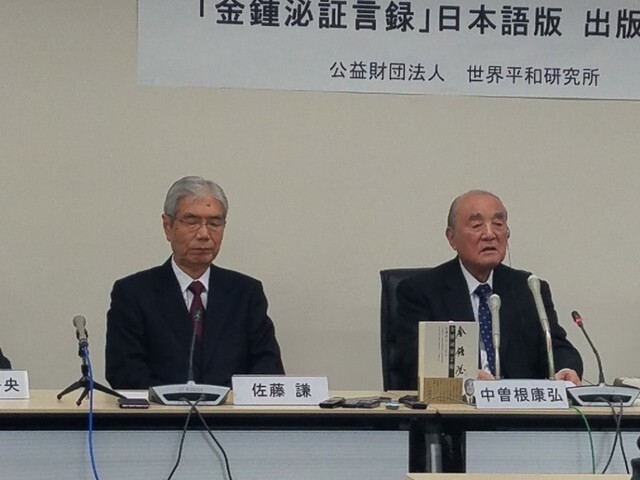hankyoreh
Links to other country sites 다른 나라 사이트 링크
Declassified diplomatic documents shed light on Japan-China relations in 1980s

Diplomatic documents declassified by the Japanese Foreign Ministry on Dec. 20 show that former Japanese Prime Minister Yasuhiro Nakasone, 99, told China in the 1980s that the South Korean government was willing to establish diplomatic relations.
During a meeting in Beijing in November 1986, Nakasone, then prime minister, told Hu Yaobang, who was then General Secretary of the Communist Party of China, that the leaders of South Korea had asked him to “communicate our desire to establish diplomatic relations with China or, if that was not feasible, to at least increase exchange with China.” Hu rejected the idea, explaining that “[South Korea’s] desire to improve relations with China is positive, but [for China to accept this] we would have to ask for the understanding of North Korea and the rest of the socialist bloc.” Four years later, in 1990, the two countries opened trade missions, which paved the way for improving bilateral relations and culminated in the establishment of diplomatic relations in 1992.
While mentioning South Korea’s desire to exchange trade missions with China, Nakasone said that Japan was also willing to take the same approach with North Korea, with which it did not have diplomatic relations. Hu replied that he would “pass along [Japan’s ideas] to North Korea and listen to their thoughts on the matter.” But two months after his meeting with Nakasone, Hu fell from power.
Nakasone’s plan to simultaneously improve relations between South Korea and China and between North Korea and Japan reflected his efforts to counter the former Soviet Union. Establishing trade missions, Nakasone told Hu, would “orient North Korea toward us instead of toward the Arctic Ocean [the Soviet Union].”
Hu told Nakasone he thought it was necessary for North and South Korea to establish a loose federal system through dialogue. Hu also said that China had broached the idea of a trilateral dialogue among South Korea, the US and North Korea, but that the North had “gotten angry” about China’s proposal.
On the topic of Chinese domestic politics, Hu also told Nakasone that he would “retire the older generation.” But before long, it was Hu the political reformer who was pushed out by senior members of the party.
Because of his efforts to close the chapter on postwar politics, Nakasone is frequently regarded as the politician who heralded the arrival of a new brand of conservatism in Japan. He was also the first prime minister to pay his respects at the controversial Yasukuni Shrine. For this reason, the Chinese government proposed in 1986 that Japan consider creating a facility to replace Yasukuni. But because of the increasing rightward shift of the current Japanese administration under Prime Minister Shinzo Abe, Nakasone seems somewhat moderate by today’s standards.
By Cho Ki-weon, Tokyo correspondent
Please direct questions or comments to [english@hani.co.kr]

Editorial・opinion
![[Column] When ‘fairness’ means hate and violence [Column] When ‘fairness’ means hate and violence](https://flexible.img.hani.co.kr/flexible/normal/500/300/imgdb/original/2024/0516/7417158465908824.jpg) [Column] When ‘fairness’ means hate and violence
[Column] When ‘fairness’ means hate and violence![[Editorial] Yoon must stop abusing authority to shield himself from investigation [Editorial] Yoon must stop abusing authority to shield himself from investigation](https://flexible.img.hani.co.kr/flexible/normal/500/300/imgdb/original/2024/0516/4417158464854198.jpg) [Editorial] Yoon must stop abusing authority to shield himself from investigation
[Editorial] Yoon must stop abusing authority to shield himself from investigation- [Column] US troop withdrawal from Korea could be the Acheson Line all over
- [Column] How to win back readers who’ve turned to YouTube for news
- [Column] Welcome to the president’s pity party
- [Editorial] Korea must respond firmly to Japan’s attempt to usurp Line
- [Editorial] Transfers of prosecutors investigating Korea’s first lady send chilling message
- [Column] Will Seoul’s ties with Moscow really recover on their own?
- [Column] Samsung’s ‘lost decade’ and Lee Jae-yong’s mismatched chopsticks
- [Correspondent’s column] The real reason the US is worried about Chinese ‘overcapacity’
Most viewed articles
- 1China calls US tariffs ‘madness,’ warns of full-on trade conflict
- 2[Column] US troop withdrawal from Korea could be the Acheson Line all over
- 3[Editorial] Yoon must stop abusing authority to shield himself from investigation
- 4[Column] When ‘fairness’ means hate and violence
- 5[Column] How to win back readers who’ve turned to YouTube for news
- 6US has always pulled troops from Korea unilaterally — is Yoon prepared for it to happen again?
- 7[Book review] Who said Asians can’t make some good trouble?
- 8Naver’s union calls for action from government over possible Japanese buyout of Line
- 9Could Korea’s Naver lose control of Line to Japan?
- 10[Editorial] Korea must respond firmly to Japan’s attempt to usurp Line